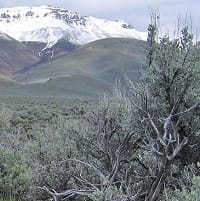Fire Ecology & Effects
View article.
Using random forest modeling and Shapley local importance measures, we found that weather and fuels were both dominant drivers of fire severity, and past fuel treatments were successful at reducing severity—even during extreme fire progression days. First-entry fires were more typically driven by top-down climate and weather variables, while for reburns (i.e., overlapping fire footprints within the period of record), severity was largely mitigated by reduced fuels and a positive influence of topography (e.g., burning downslope). Likewise, reburns overall exhibited lower fire severity than first entry fires, suggesting strong negative feedbacks associated with past fire footprints. The normalized difference moisture index (NDMI)—an indicator of live fuel loading and moisture levels—was a leading predictor of fire severity for both first-entry fires and reburns. NDMI values < 0 (i.e., low biomass) were associated with reduced fire severity, while values > 0.25 (i.e., high biomass) were associated with increased severity. Forest management was effective across a variety of conditions, especially under low to moderate wind speeds (< 17 m·s−1), and where canopy base heights were ≥ 1.3 m.
View article.
To assess relationships between fire spread rates and landscape burn severity patterns, we used satellite fire detections to create day-of-burning maps for 623 fires comprising 4267 single-day events within forested ecoregions of the southwestern United States. We related satellite-measured burn severity and a suite of high-severity patch metrics to daily area burned. Extreme fire spread events (defined here as burning > 4900 ha/day) exhibited higher mean burn severity, a greater proportion of area burned severely, and increased like adjacencies between high-severity pixels. Furthermore, increasing daily area burned also resulted in greater distances within high-severity patches to live tree seed sources. High-severity patch size and total high-severity core area were substantially higher for fires containing one or more extreme spread events than for fires without an extreme event. Larger and more homogenous high-severity patches produced during extreme events can limit tree regeneration and set the stage for protracted forest conversion. These landscape outcomes are expected to be magnified under future climate scenarios, accelerating fire-driven forest loss and long-term ecological change.
View article.
We studied the impact of increased fire frequencies on the composition and abundance of herbaceous and woody species in the Interior Coast Range of northern California. Our study area is one of the most frequently burned areas in California, which allowed us to investigate higher fire frequencies than previously published in the scientific literature for California. We surveyed fifty-four 250-m2 plots to assess changes in plant community composition and postfire regeneration of chaparral shrubs across a wide range of fire frequencies, including plots that have burned up to six times in the past 30 years. Our findings reveal that short-interval fires significantly reduced postfire native woody regeneration, with obligate seeding species experiencing a 99% reduction and facultative species showing an 83% reduction in regeneration in the most frequently burned plots. Moreover, the overall marginal effect of one additional fire since 1985 decreased the proportion of native species cover by 12% and both richness and Shannon diversity by 4%. Consequently, areas with higher fire recurrence supported a more structurally and botanically homogeneous landscape dominated by a homogeneous group of non-native species.
View story map.
Across western North America, drought (measured by vapor pressure deficit [VPD], or how dry the atmosphere is) has contributed to a considerable increase in wildfire activity and extent in recent decades . Fire seasons are not only getting drier, they are also getting longer.
View article and brief.
Although fuels treatments are generally shown to be effective at reducing fire severity, there is widespread interest in monitoring that efficacy as the climate continues to warm and the incidence of extreme fire weather increases. This paper compared basal area mortality across adjacent treated and untreated sites in the 2021 Dixie Fire of California’s Sierra Nevada.
View article.
This study defines five metrics that collectively provide comprehensive and complementary insights into the effect of fire regimes on ecosystem resilience and components of biodiversity. These include (1) Species Habitat Availability, a measure of the amount of suitable habitat for individual species; (2) Fire Indicator Species Index, population trends for species with clear fire responses; (3) Vegetation Resilience, a measure of plant maturity and the capability of vegetation communities to regenerate after fire; (4) Desirable Mix of Growth Stages, an indicator of the composition of post-fire age-classes across the landscape; and (5) Extent of High Severity Fire, a measure of the effect of severe fire on post-fire recovery of treed vegetation communities. Each metric can be quantified at multiple spatial and temporal scales relevant to evaluating fire management outcomes. Results highlight four characteristics of metrics that enhance their value for management: (1) they quantify both status and trends through time; (2) they are scalable and can be applied consistently across management levels (from individual reserves to the whole state); (3) most can be mapped, essential for identifying where and when to implement fire management; and (4) their complementarity provides unique insights to guide fire management for ecological outcomes.
Conference webpage. 42nd Annual Salmonid Restoration Conference: Fish & Fire 2025: Where There Are Fish, There is Fire 30 April 2025 Workshop Coordinator: Lenya N Quinn-Davidson, University of California Agriculture and Natural Resources
The US Geological Survey Land Management Research Program and the Great Basin Fire Science Exchange teamed up to bring you updates in sagebrush, fire, and wildlife related research.
Dates, Topics, and Presentations:
1/30 – Sage-grouse, carbon topics
Webinar recording
Summary webpage
Program with speakers, talks, and resources
- Greater sage-grouse hierarchical population monitoring framework: Range-wide application of an early warning systems for populations at-risk – Coates, Weise et al.
- Evaluating the effectiveness of conservation actions directed for greater sage-grouse using hierarchical models and the Conservation Efforts Database – Coates et al.
- Greater sage-grouse range-wide seasonal habitat maps: Identifying regional thresholds and relationships between trends and seasonal habitat use – Wann et al.
- Characterizing the environmental drivers of range-wide gene flow for greater sage-grouse – Zimmerman et al.
- Characterizing greater sage-grouse climate driven maladaptation – Zimmerman et al.
- Quantifying carbon storage and greenhouse gas emissions in sagebrush rangelands to inform management for carbon resilience – Bagcilar et al.
2/6 – Invasive species, restoration effectiveness, and monitoring
Webinar recording
Summary webpage
Program with speakers, talks, and resources
- Develop annual herbaceous percent cover maps in near-real time – Boyte et al.
- Proliferation of fine fuels: Assessing under future climatic conditions – Roche et al.
- Optimizing sagebrush restoration and management actions to increase connectivity within the Sagebrush Conservation Design – Tarbox et al.
- Assessing cheatgrass treatment efficacy across the sagebrush biome – Tarbox et al.
- Simulating trends in land health components under treatment scenarios and Sagebrush Conservation Design – Christensen et al.
- Biome-wide vegetation change monitoring and warning system – Aldridge et al.
- Vectors of annual grass invasion – Roche et al.
- Predicting reburn risk to restoration investments – Applestein et al.
2/20 – Monitoring, pinyon-juniper, and fuels management
Webinar recording
Summary webpage
Program with speakers, talks, and resources
- Planning for conservation delivery success: Linking biome-wide Sagebrush Conservation Design to local treatment planning by leveraging landscape restoration outcomes- Arkle et al.
- Technical transfer tools for the Nevada and Oregon rangeland monitoring project (NORMP) – Pilliod et al.
- Rapid and Other Assessment and Monitoring Methods (ROAM) project – Jeffries et al.
- Pinyon-juniper treatments for minimizing climate and fire vulnerability – Noel et al.
- Synthesis and forecasts of pinyon-juniper woodland die-off – Wion (No recording)
- Synthesizing scientific information on treatment and natural disturbance effects on pinyon-juniper woodlands and associated wildlife habitat – Halperin et al.
2/27 – Fire, fuels management, invasive species –
Webinar recording
Summary webpage
Program with speakers, talks, and resources
- Effectiveness of layering treatments in the “multiple-intervention” response to wildfire in sagebrush steppe – Germino et al.
- A collaborative and iterative framework for delivering applied fuel break science: With a focus on sagebrush ecosystems and the Great Basin – Shinneman et al.
- UAS survey of sagebrush fuel breaks – Shinneman et al.
- Invasive annual grass – Economic assessment – Orning et al.
- Longevity of herbicides targeting exotic annual grasses in sagebrush-steppe soils – Germino et al.
- Synthesis of indaziflam outcomes for protecting sagebrush ecosystems – Roche et al.
- Can ruderal components of biocrust be maintained under increasing threats of drought, grazing, and wild horses? Condon et al.
3/6 – Climate, vegetation trends, and big game
Webinar recording
Summary webpage
Program with speakers, talks, and resources
- Rangeland Condition Monitoring Assessment and Projection (RCMAP) vegetation trend summaries – Rigge
- Integrating climate, sagebrush ecological integrity, and grazing – Holdrege et al.
- Influence of future climate scenarios on habitat and population dynamics of greater sage-grouse – O’Neil et al.
- Understanding and forecasting environmental controls over plant establishment in sagebrush ecosystems to enhance restoration success – Siegmund, Stears et al.
- Treatment and post-fire assessment tools for management of the sagebrush ecosystem – Duniway, Tyree et al.
- Science to support elk management efforts to reduce CWD risk – Janousek et al.
View (and/or order) the poster.
Sagebrush ecosystems, broadly distributed across western North America (see map), are imperiled due to a combination of modern and historical factors causing widespread degradation and habitat loss. Sagebrush shrubs are so common in these ecosystems that they create a “sea” across the landscape. This poster highlights wildflowers (forbs) common in sagebrush vegetation of the Great Basin.
These wildflowers support countless wildlife species, including some species only found in sagebrush ecosystems, such as the greater sage-grouse. (See “High sage-grouse value.”) Many forb species (including most featured here) are highly valued and used for food, medicine and ceremony by the many Indigenous peoples of the Great Basin. There are hundreds of forb species in sagebrush ecosystems, all with their own unique characteristics. The 31 species on this poster highlight common species potentially useful in restoration. These species also represent the variety of size, height, flowering timing and taxonomy (evolutionary relationships) found in typical sagebrush communities. Note: These species rarely, if ever, occur as closely together as shown in this poster.
View article.
We sampled depth-resolved layers from fire-impacted soil and combusted litter and woody materials in a series of recent pile burn scars near West Yellowstone, Montana and nearby unburned mineral soil controls to assess whether the pile burn scars exhibited microbial signatures characteristic of forest soils impacted by recent high severity wildfire. Changes in soil carbon and nitrogen chemistry and patterns of microbial alpha and beta diversity broadly aligned with those observed following wildfire, particularly the enrichment of so-called ‘pyrophilous’ taxa. Furthermore, many of the taxa enriched in burned soils likely encoded putative traits that benefit microorganisms colonizing these environments, such as the potential for fast growth or utilization of pyrogenic carbon substrates. We suggest that pile burn scars may represent a useful proxy along the experimental gradient from muffle furnace or pyrocosm studies to largescale prescribed burns in the field to advance understanding of the soil (and related layers, like ash) microbiome following high severity wildfires, particularly when coupled with experimental manipulation. Finally, we discuss existing research gaps that experimentally manipulated pile burns could be utilized to address.






